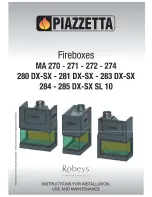
W415-1517 / A / 09.02.16
46
EN
9.3
CREOSOTE FORMATION AND REMOVAL
85.2C
!
WARNING
A CHIMNEY FIRE CAN PERMANENTLY DAMAGE YOUR CHIMNEY SYSTEM. THIS DAMAGE CAN
ONLY BE REPAIRED BY REPLACING THE DAMAGED COMPONENT PARTS. CHIMNEY FIRES ARE
NOT COVERED BY THE LIFETIME LIMITED WARRANTY.
CAUSES:
•
Using incorrect fuel, or small fuel pieces which would normally be used as kindling.
•
Creosote build up in chimney.
SOLUTIONS:
•
Do not burn treated, painted, artifi cial, paper or processed wood logs, coal, charcoal, coloured paper or
cardboard.
•
Have chimney regularly cleaned.
IN CASE OF A CHIMNEY FIRE:
•
Close glass door.
•
Have a well understood plan for evacuation and a place outside for everyone to meet. Prepare to
evacuate to ensure everyone’s safety.
• Call
local
fi re department. Have a fi re extinguisher handy. Contact local authorities for further
information on how to handle a chimney fi re.
•
After the chimney fi re is out, clean and inspect the chimney or chimney liner for stress and cracks prior
to lighting another fi re. Also check combustibles around the chimney and the roof
84.1A
When wood is burned slowly, it produces tar and other organic vapors, which combine with expelled moisture
to form creosote. The creosote vapors condense in the relatively cooler chimney fl ue of a slow-burning fi re. As
a result, creosote residue accumulates on the fl ue lining. When ignited this creosote makes an extremely hot
fi re.
The chimney connector and chimney should be inspected at least once every two months during the heating
season to determine if a creosote buildup has occurred.
If creosote has accumulated it should be removed to reduce the risk of a chimney fi re.
9.4
RUN-AWAY OR CHIMNEY FIRE
Tips for Prolonging Catalyst Life
•
Do not over fi re the stove
•
Monitor catalyst temperatures
•
Avoid thermal shock (heating or cooling catalyst too quickly)
•
Inspect Catalyst regularly
•
Do not burn anything other than high quality wood mentioned in this manual.
















































